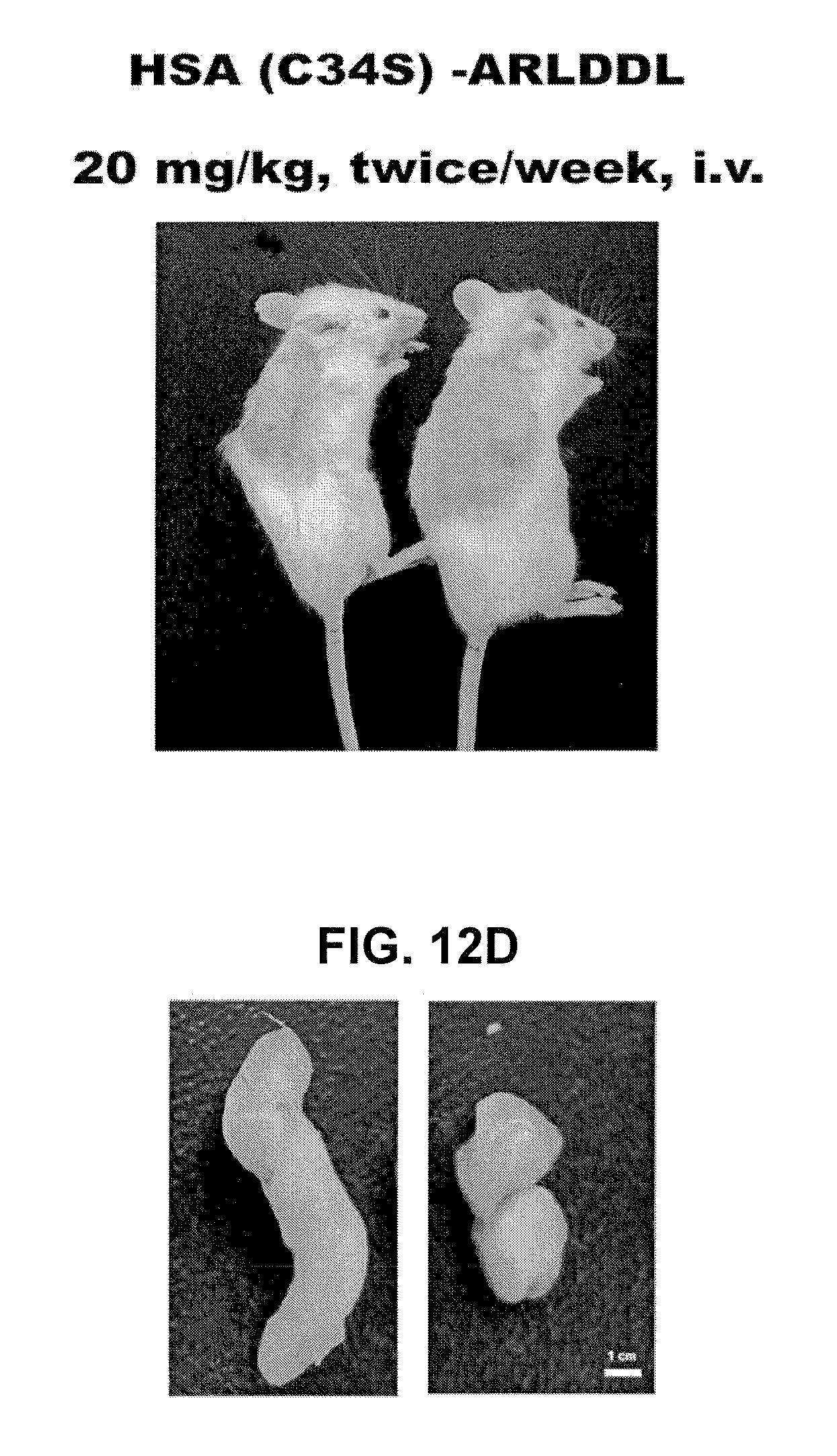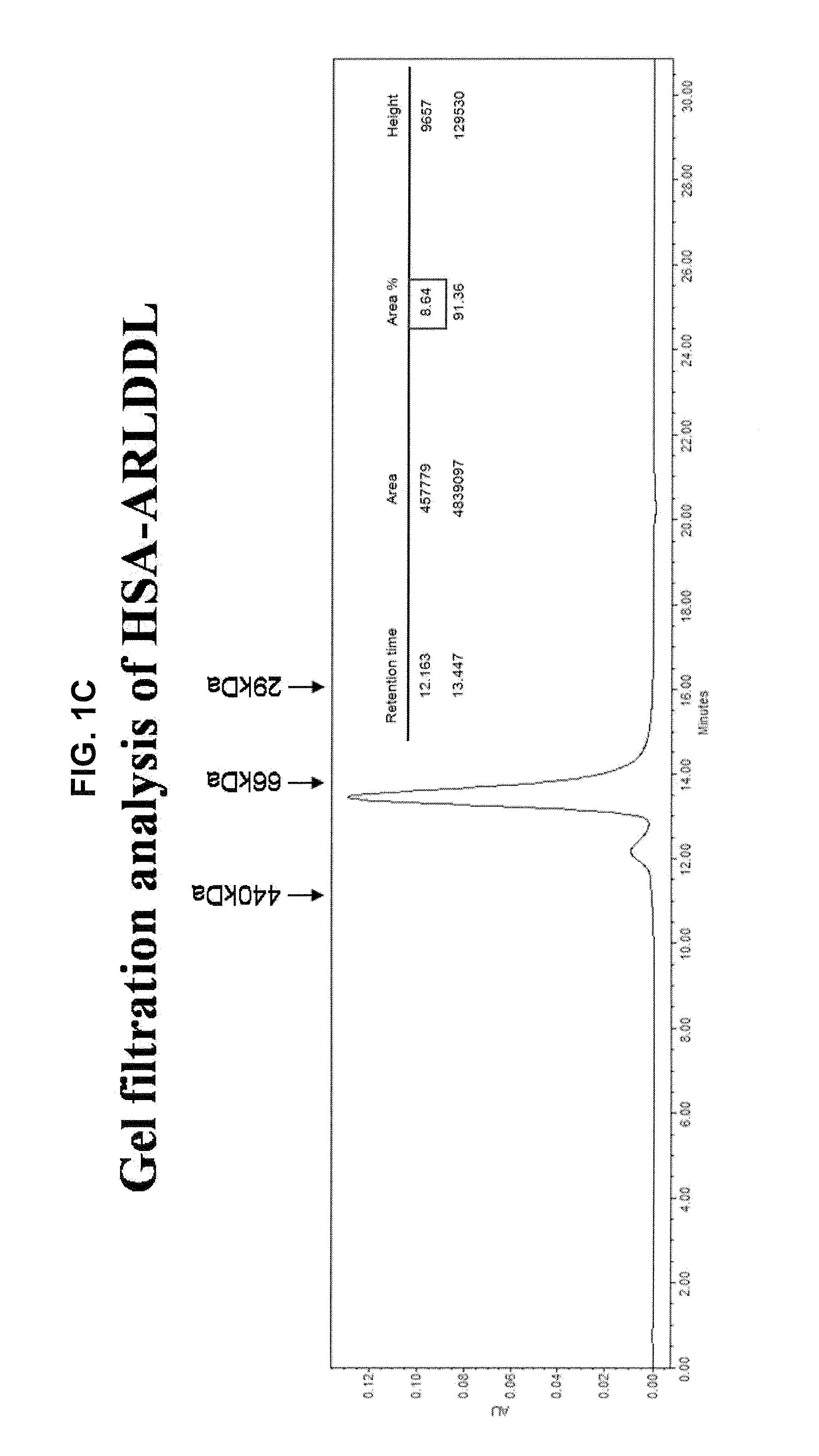Polypeptides Selective for alphavbeta3 Integrin Conjugated With a Variant Of Human Serum Albumin (HSA) And Pharmaceutical Uses Thereof
a technology of human serum albumin and polypeptide, which is applied in the field of fusion proteins, can solve the problems of intermolecular dimers, rhodostomin may cause serious side effects, and undesirable side effects of platelet aggregation inhibition, and achieves high selectiveness and reduced binding
- Summary
- Abstract
- Description
- Claims
- Application Information
AI Technical Summary
Benefits of technology
Problems solved by technology
Method used
Image
Examples
example 1
Construction of a Gene Encoding HSA(C34S)-ARLDDL
example 1a
Construction of a Gene Encoding HSA(C34S)-ARLDDL Via Overlap Extension PCR and Ligation
[0174]The structural gene of HSA C34S was constructed using HSA (Invitrogen®, clone ID: IOH23065) as a template. The mutation of C34S was produced by two-step polymerase chain reaction (PCR). The first PCR was amplified with the sense primer containing C34S mutation site and with the antisense primer containing Kpn I, Sac II restriction sites and a TAA stop codon. The second PCR was amplified with the sense primer containing BstB I restriction site and the secretion signal sequence and with the antisense primer containing Kpn I, Sac II restriction sites and a TAA stop codon. The secretion signal sequence of HSA prepro peptide, the α factor prepro peptide from Saccharomyces cerevisiae, or preHSA and pro a factor fusion peptide was used for secretory protein expression. The structural gene of ARLDDL was amplified by PCR with the sense primer containing Kpn I restriction site and the spacer region co...
example 1b
Construction of a Gene Encoding HSA(C34S)-ARLDDL Via Gene Synthesis
[0175]The DNA encoding secretion signal sequence HSA(C34S)-ARLDDL was synthesized. The secretion signal sequence of HSA prepro peptide, the α factor prepro peptide from Saccharomyces cerevisiae, or preHSA and pro α factor fusion peptide was used for secretory protein expression. The resulting gene product was cloned into the yeast recombination vector with proper restriction site. The recombinant plasmid was then transformed into an Escherichia coli XL1-blue strain, and the colonies were selected using the agar plates with low salt LB (1% tryptone, 0.5% yeast extract, 0.5% NaCl, 1.5% agar at pH 7.0) and 25 μg / ml antibiotic Zeocin. The E. coli XL1-blue colonies were picked and the plasmid DNA was isolated and sequenced.
PUM
| Property | Measurement | Unit |
|---|---|---|
| Molar density | aaaaa | aaaaa |
| Molar density | aaaaa | aaaaa |
| Molar density | aaaaa | aaaaa |
Abstract
Description
Claims
Application Information
 Login to View More
Login to View More - R&D
- Intellectual Property
- Life Sciences
- Materials
- Tech Scout
- Unparalleled Data Quality
- Higher Quality Content
- 60% Fewer Hallucinations
Browse by: Latest US Patents, China's latest patents, Technical Efficacy Thesaurus, Application Domain, Technology Topic, Popular Technical Reports.
© 2025 PatSnap. All rights reserved.Legal|Privacy policy|Modern Slavery Act Transparency Statement|Sitemap|About US| Contact US: help@patsnap.com



